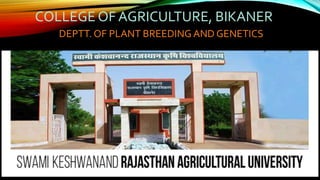
Gene Interaction
- 1. COLLEGE OF AGRICULTURE, BIKANER DEPTT. OF PLANT BREEDING AND GENETICS
- 2. ASSIGNMENT ON GENE INTERACTION Submitted To:- By:- NAVREET KAUR RAI Dr. N. K. SHARMA (M. Sc. (Ag.) PBG Pre. year) (2018-19)
- 3. OUTLINE • Introduction • Why gene interaction..? • Types of gene interaction • Epistatic and hypostatic gene • Classification of epistatic gene interaction a. Supplementary gene interaction (9:3:4) b. Complementary gene interaction (9:7) c. Inhibitory gene interaction (13:3) d. Duplicate gene interaction (15:1) e. Masking gene action (12:3:1) f. Polymeric gene interaction (9:6:1)
- 4. INTRODUCTION • Definition- The phenomenon of two or more genes affecting the expression of each other in various ways in the development of a single character of an organism is known as gene interaction. • Most of the characters of living organisms are controlled/ influenced/ governed by a collaboration of several different genes. • Mendel and other workers assumed that characters are governed by single genes but later it was discovered that many characters are governed by two or more genes. • Such genes affect the development of concerned characters in various ways; this lead to the modification of the typical dihybrid ratio (9:3:3:1) or trihybrid (27:9:9:9:3:3:3:1). • In gene Interaction, expression of one gene depends on expression(presence or absence) of another gene.
- 5. WHY GENE INTERACTION… ? • There may be more than two alleles for a given locus within the population. • Dominance of one allele over another may not be complete. • Two or more genes may affect a single trait. • The expression of a trait may be dependent on the interaction of two or more genes, on the interaction of genes with non genetic factors, or both.
- 6. TYPES OF GENE INTERACTIONS • Gene interactions can be classified as- a) ALLELIC/NON EPISTATIC GENE INTERACTION- This type of interaction gives the classical ratio of 3:1 or 9:3:3:1. b) NON-ALLELIC/EPISTATIC GENE INTERACTION – In this type of gene interaction genes located on same or different chromosome interact with each other for their expression.
- 7. EPISTATIC AND HYPOSTATIC GENE • Epistatic gene:- When a gene or locus which suppress or mask the phenotypic expression of another gene at another locus such gene is known as epistatic gene. Epistatic is GREEK term and meaning is standing up. • Hypostatic gene:- The gene or locus which was suppressed by a epistatic gene was called hypostatic gene.
- 8. CLASSIFICATION OF EPISTATIC GENE INTERACTION • Epistatic gene interaction is classified as follow on the basis of manner by which concerned genes influence the expression of each other- 1. No interaction (9:3:3:1) 2. Supplementary gene interaction / Recessive Epistasis (9:3:4) 3. Complementary gene interaction (9:7) 4. Inhibitory gene interaction / Dominant Suppression (13:3) 5. Duplicate gene interaction (15:1) 6. Masking gene interaction / Dominant Epistasis (12:3:1) 7. Polymeric gene interaction / Dominant gene interaction (9:6:1)
- 9. 1. TYPICAL DIHYBRID RATIO (9:3:3:1) The character is governed by two genes exhibiting FULL dominance.
- 10. 2. SUPPLEMENTARY GENE INTERACTION (9:3:4) • In supplementary gene interaction, the dominant allele of one of two gene governing a character produces phenotypic effect. • However dominant allele of the other gene does not produce a phenotypic effect on its own. • But when it is present with dominant allele of the first gene it modifies the phenotypic effect produced by that gene. • Also known as Recessive Epistasis. • For example:- Purple and White Grain colour in Maize.
- 12. 3. COMPLEMENTARY GENE INTERACTION (9:7) • The character is governed by the dominant alleles of two genes, whether they are present in homozygous state or heterozygous state. • In such case, the genotype aaBB, aaBb, Aabb, aabb produce one phenotype. • Both dominant alleles when present together each other are called complementary genes and produce a different phenotype. • Also known as Duplicate Recessive Epistasis. • For example:- Flower colour in Sweet pea.
- 14. 4. INHIBITORY GENE INTERACTION (13:3) • The character is governed by one of the two dominant genes however; second dene has no effect of its own but stop the expression of first dominant gene. • When dominant allele of one gene locus in homozygous and heterozygous condition produce the same phenotype the F2 ratio become 13:3 instead of 9:3:3:1. • Homozygous recessive condition inHibits phenotypic expression of other genes so known as inhibitory gene action. • Also known as Dominant Suppression. • For example:- Maize Aleurone colour.
- 16. 5. DUPLICATE GENE INTERACTION (15:1) • The character is governed by two dominant genes whether they are present alone or together. • In this case the ratio becomes 15:1 instead of 9:3:3:1. • Also known as Duplicate Dominant Epistasis. • For example:- Awn character in Rice.
- 18. 6. MASKING GENE INTERACTION (12:3:1) • When out of two genes, the dominant allele of one gene(A) masked the activity of allele of another gene(B). • Then A gene locus is said to be epistatic to the B gene locus. • Dominant allele A express itself only in the presence of either B or b so such type of epistatic is known as dominant epistatic. • The allele of hypostatic locus express only when the allele of epistatic locus present in homozygous recessive condition. • For example:- Fruit colour in squash gourd.
- 20. 7. POLYMERIC GENE INTERACTION (9:6:1)
- 21. ….THANK YOU….